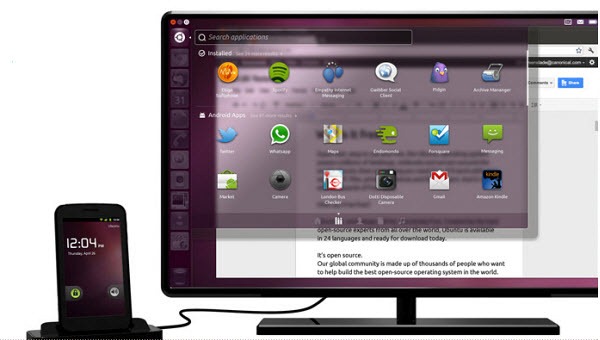 Canonical today announced Ubuntu for Android, a unique version of Ubuntu that is designed to seamlessly integrate Android with the Linux distribution. This is not an Ubuntu app running atop Android, nor it is an Ubuntu device running an Android emulator. Rather, Ubuntu for Android is a full Ubuntu desktop running side-by-side with Android on the same phone.
Canonical today announced Ubuntu for Android, a unique version of Ubuntu that is designed to seamlessly integrate Android with the Linux distribution. This is not an Ubuntu app running atop Android, nor it is an Ubuntu device running an Android emulator. Rather, Ubuntu for Android is a full Ubuntu desktop running side-by-side with Android on the same phone.
Designed to coexist with Android on multicore smartphones, the new version of Ubuntu will launch to a full Ubuntu desktop when the phone is docked with a keyboard and monitor. The rest of the time, the phone runs Android as usual. The installation basically gives you two devices in one: an Android phone while on the go, and a Ubuntu desktop when plugged in. Thanks to tight integration with the Android service layer, the transition between the two environments is seamless, making it easy to access the phone's services from the desktop when docked.

Ubuntu for Android will offer a full range of desktop applications including office, web browsing, email, media and messaging. Both Ubuntu and Android access the same mobile address book. So even when the phone is docked, you can view, edit, call, text or email a contact. Personal information like contacts, calendars, photo galleries and music can be accessed from both the phone and the desktop interface. SMS texts arrive on your desktop if you are docked when they show up, and calls are handled like VoIP if you want to stay working while you chat. A pop-up window appears when you receive a call, and you can simply mouse over and click to answer.

Ubuntu for Android will give mobile users a compelling reason to upgrade to multi-core handsets with more RAM, more storage, faster GPUs and CPUs. It’s not just a phone they are buying, it’s a desktop too. While mid-range phones can deliver a perfect Android experience, it takes high-end horsepower to drive a phone and a desktop at the same time.
The hardware requirements are, expectedly, a bit steep – dual-core 1GHz CPU, 2GB of storage for OS disk image, and 512 MB of RAM. Your phone will also need the docking capability and hardware support for HDMI and USB. But that’s standard for high-end models in the current generation of devices.
There is no installable version yet. Canonical says that Ubuntu for Android will be loaded onto phones by manufacturers, and but these devices aren’t yet available, but can be expected to land in late 2012.
[via Wired]

Comments
Post a Comment